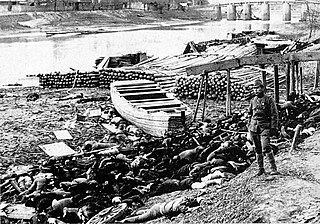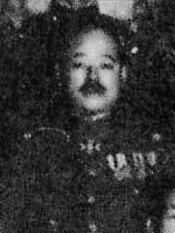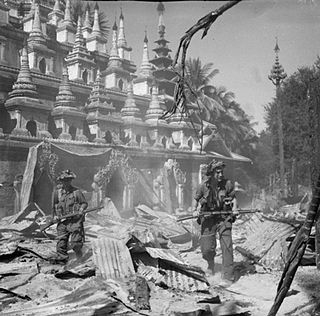
The Nanjing Massacre or the Rape of Nanjing was an episode of mass murder and mass rape committed by Imperial Japanese troops against the residents of Nanjing (Nanking), then the capital of China, during the Second Sino-Japanese War.

The Second Sino-Japanese War was a military conflict that was primarily waged between the Republic of China and the Empire of Japan from July 7, 1937, to September 2, 1945. The start of the war is typically considered to be the Marco Polo Bridge Incident in 1937, in which a dispute between Japanese and Chinese troops escalated into a full-scale invasion. Some sources in the modern People's Republic of China date the beginning of the war to the Japanese invasion of Manchuria in 1931. In China, it is known as the War of Resistance against Japanese Aggression.

The Pacific War, sometimes called the Asia–Pacific War, was the theater of World War II that was fought in Asia, the Pacific Ocean, the Indian Ocean, and Oceania. It was geographically the largest theater of the war, including the vast Pacific Ocean theater, the South West Pacific theater, the South-East Asian theater, the Second Sino-Japanese War, and the Soviet–Japanese War.

Field Marshal William Joseph Slim, 1st Viscount Slim,, usually known as Bill Slim, was a British military commander and the 13th Governor-General of Australia.

Tomoyuki Yamashita was a Japanese general of the Imperial Japanese Army during World War II. Yamashita led Japanese forces during the invasion of Malaya and Battle of Singapore, with his accomplishment of conquering Malaya and Singapore in 70 days earning him the sobriquet "The Tiger of Malaya" and led to the British Prime Minister Winston Churchill calling the ignominious fall of Singapore to Japan the "worst disaster" and "largest capitulation" in British military history. Yamashita was assigned to defend the Philippines from the advancing Allied forces later in the war, and while unable to prevent the Allied advance, he was able to hold on to part of Luzon until after the formal Surrender of Japan in August 1945.

The Sook Ching was a systematic purge of perceived hostile elements among the Chinese in Singapore by the Japanese military during the Japanese occupation of Singapore and Malaya, after the British colony surrendered on 15 February 1942 following the Battle of Singapore. The purge took place from 18 February to 4 March 1942 at various places in the region. The operation was overseen by the Imperial Japanese Army's Kempeitai secret police and subsequently extended to include the Chinese population in Malaya.

War crimes were committed by the Empire of Japan in many Asian-Pacific countries during the period of Japanese imperialism, primarily during the Second Sino-Japanese War and World War II. These incidents have been described as an "Asian Holocaust". Some war crimes were committed by Japanese military personnel during the late 19th century, but most Japanese war crimes were committed during the first part of the Shōwa Era, the name which was given to the reign of Emperor Hirohito, until the surrender of the Empire of Japan in 1945.
During World War II, Japanese forces invaded Burma, that was then under British colonial rule. The British forces retreated and in the power vacuum left behind, considerable inter communal violence erupted between pro-Japanese Buddhist Rakhine and pro-British Muslim villagers. As part of the 'stay-behind' strategy to impede the Japanese advance, the Commander-in-Chief of forces in Delhi, Wavell, established "V-Force" which armed Rohingya locals in northern Arakan to create a buffer zone from Japanese invasion when they retreated.

The Manila massacre, also called the Rape of Manila, involved atrocities committed against Filipino civilians in the City of Manila, the capital of the Philippines, by Japanese troops during the Battle of Manila which occurred during World War II. The total number of civilians who were killed during the battle of Manila was about 100,000.

On 23 January 1942, the Parit Sulong Massacre in Johor, Malaya was committed against Allied soldiers by members of the Imperial Guards Division of the Imperial Japanese Army. A few days earlier, the Allied troops had ambushed the Japanese near Gemas and blown up a bridge there.

Malaya was gradually occupied by the Japanese between 8 December 1941 and the Allied surrender at Singapore on 16 February 1942. The Japanese remained in occupation until their surrender to the Allies in 1945. The first Japanese garrison in Malaya to lay down their arms was in Penang on 2 September 1945 aboard HMS Nelson.
The Japanese occupation of Burma was the period between 1942 and 1945 during World War II, when Burma was occupied by the Empire of Japan. The Japanese had assisted formation of the Burma Independence Army, and trained the Thirty Comrades, who were the founders of the modern Armed Forces (Tatmadaw). The Burmese hoped to gain support of the Japanese in expelling the British, so that Burma could become independent.

Takuma Nishimura was a Japanese army general in the Imperial Japanese Army during World War II. After the Japanese surrender, he was tried by Britain and later Australia for war crimes. He was executed in the then Australian territory of Papua and New Guinea. Nishimura was a native of Fukuoka prefecture.

The internal conflict in Myanmar is a series of primarily ethnic conflicts within Myanmar that began shortly after the country, then known as Burma, became independent from the United Kingdom in 1948. The conflict is the world's longest ongoing civil war.

The Burma campaign in the South-East Asian Theatre of World War II was fought primarily by British Commonwealth, Chinese and United States forces against the forces of Imperial Japan, who were assisted to some degree by Thailand, the Burmese National Army and the Indian National Army. The British Commonwealth land forces were drawn primarily from the United Kingdom, British India and Africa.
This is a timeline of events that occurred during 1944 in World War II.
On 7 July 1945, the Kalagong massacre was committed against inhabitants of Kalagong, Burma, by members of the 3rd Battalion, 215th Regiment and the OC Moulmein Kempeitai of the Imperial Japanese Army. These units had been ordered by Major General Seiei Yamamoto, chief of staff of the 33rd Army, to sweep the area for guerrillas reportedly teamed with British paratroops.
The Panthay rebellion (1856–1873), known to Chinese as the Du Wenxiu Rebellion, was a rebellion of the Muslim Hui people and other ethnic groups against the Manchu rulers of the Qing Dynasty in southwestern Yunnan Province, as part of a wave of Hui-led multi-ethnic unrest.
Violent clashes have been ongoing in the northern part of Myanmar's Rakhine State since October 2016. Insurgent attacks by the Arakan Rohingya Salvation Army (ARSA) have led to sectarian violence perpetrated by Myanmar's military and the local Buddhist population against predominantly Muslim Rohingya civilians. The conflict has sparked international outcry and was described as an ethnic cleansing by the United Nations High Commissioner for Human Rights. In August 2017, the situation worsened and hundreds of thousands of refugees fled Myanmar into Bangladesh, with an estimated 500,000 refugees having arrived by 27 September 2017. In January 2019, Arakan Army insurgents raided border police posts in Buthidaung Township, joining the conflict and beginning their military campaign in northern Rakhine State against the Burmese military.

The Inn Din massacre was a mass execution of Rohingyas by the Myanmar Army and armed Rakhine locals in the village of Inn Din, in Rakhine State, Myanmar on 2 September 2017. The victims were accused of being members of the Arakan Rohingya Salvation Army (ARSA) by authorities. An investigation by Myanmar's military concluded on 10 January 2018 that there was indeed a mass execution of Rohingyas in Inn Din, marking the first instance where the military admitted to extrajudicial killings during their "clearance operations" in the region.















